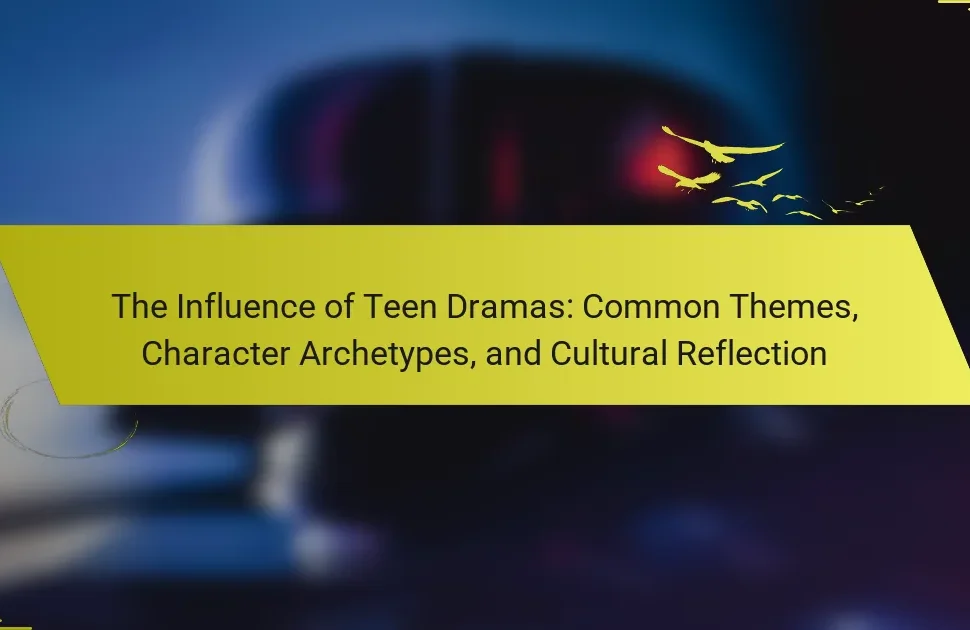The comedy genre encompasses literature, film, and performance designed to entertain and elicit laughter through various humor techniques, such as exaggeration and absurdity. Key subgenres of comedy include stand-up, sketch, sitcom, and improv, each with unique characteristics that cater to diverse audiences. Notable shows like “Friends,” “The Office,” and “Parks and Recreation” exemplify the genre’s impact and cultural significance. Comedy serves as a means of escape from daily stressors, fostering community and exploring social issues in an accessible manner. The physiological benefits of laughter further enhance the enjoyment of comedic content, making it a vital aspect of entertainment.

What is the Comedy Genre?
The comedy genre is a category of literature, film, and performance that aims to entertain and provoke laughter. It often employs humor through various techniques, including exaggeration, absurdity, and wordplay. Comedies typically feature lighthearted themes and situations. They may involve misunderstandings, mistaken identities, or social satire. The genre has roots in ancient theater, notably with Greek comedies by playwrights like Aristophanes. Modern examples include sitcoms and stand-up performances. The success of comedy is often measured by audience reactions, such as laughter and enjoyment.
How did the Comedy Genre evolve over time?
The comedy genre evolved significantly over time, reflecting societal changes and cultural contexts. Early forms of comedy included ancient Greek plays, which often featured satire and social commentary. The Roman era introduced farce and slapstick, emphasizing physical humor. In the Middle Ages, comedy was present in morality plays and commedia dell’arte, showcasing improvisation and stock characters. The Renaissance saw the rise of Shakespearean comedies, blending wit with romance. The 19th century introduced vaudeville and burlesque, focusing on variety acts and humor. The 20th century marked the advent of film and television, popularizing sitcoms and stand-up comedy. Today, the genre incorporates diverse styles, including dark humor and satirical commentary, adapting to modern sensibilities. Each evolution mirrors the cultural landscape and audience expectations of its time.
What historical influences shaped modern comedy?
Modern comedy has been shaped by several historical influences. The ancient Greeks laid foundational elements through their theatrical performances. Comedies by playwrights like Aristophanes introduced satire and humor that critiqued society. The Roman era further developed comedic forms with playwrights such as Plautus and Terence. They incorporated farce and slapstick, influencing later comedic styles. The Renaissance period revived interest in classical comedy, leading to works by Shakespeare that blended humor with serious themes. The rise of vaudeville in the 19th century introduced variety acts and sketch comedy, shaping modern formats. Additionally, the advent of film and television in the 20th century revolutionized comedy, allowing for broader reach and diverse styles. These historical influences collectively contributed to the evolution of modern comedic forms and techniques.
How do cultural differences impact comedic styles?
Cultural differences significantly impact comedic styles by shaping humor’s context and delivery. Different cultures have unique values, beliefs, and social norms that influence what is considered funny. For instance, Western comedy often relies on individualism and sarcasm, while Eastern comedy may emphasize group harmony and subtlety. Additionally, language plays a crucial role in comedy. Puns and wordplay may resonate in one culture but not translate well to another. Cultural references in jokes can also lead to misunderstandings across different audiences. Studies show that humor preferences vary globally, reflecting local traditions and societal issues. This diversity in comedic styles highlights the importance of cultural context in humor appreciation.
What are the key characteristics of the Comedy Genre?
The key characteristics of the Comedy Genre include humor, exaggeration, and relatability. Humor often manifests through witty dialogue, slapstick, or situational comedy. Exaggeration is used to create absurd situations or characters that amplify comedic effects. Relatability allows audiences to connect with characters and scenarios, fostering engagement. Common themes include misunderstandings, social norms, and everyday life experiences. The genre often employs comedic timing and pacing to enhance laughter. Various subgenres, like romantic comedy and satire, diversify the comedic landscape. Historical examples include vaudeville and sitcoms, which have shaped modern comedy.
What elements define humor in comedy?
Humor in comedy is defined by elements such as timing, delivery, and relatability. Timing refers to the precise moment a joke is delivered for maximum effect. Delivery encompasses the style and manner in which a joke is presented, including tone and body language. Relatability allows audiences to connect with the humor based on shared experiences or cultural references. Additionally, surprise plays a crucial role, as unexpected twists can enhance comedic impact. Wordplay and puns are also significant, utilizing language creatively to evoke laughter. These elements work together to engage the audience and elicit a humorous response.
How do comedic timing and delivery affect audience response?
Comedic timing and delivery significantly influence audience response. Effective timing creates anticipation and enhances punchlines. Proper delivery conveys emotion and character, making jokes relatable. Studies indicate that well-timed jokes result in higher laughter rates. For instance, a study by Paul E. McGhee highlights that timing can double the effectiveness of a joke. Delivery styles, such as tone and pace, also shape audience engagement. Research shows that varied delivery can increase audience retention of humor. Overall, the combination of timing and delivery is crucial for maximizing comedic impact.

What are the essential subgenres of comedy?
The essential subgenres of comedy include stand-up, sketch, sitcom, and improv. Stand-up comedy features a comedian performing in front of a live audience. It often involves personal anecdotes and observational humor. Sketch comedy consists of short comedic scenes or vignettes. These scenes usually involve a cast of characters and a comedic premise. Sitcoms are television shows that focus on a fixed set of characters in humorous situations. They often rely on situational humor and character development. Improv comedy is unscripted and relies on audience suggestions. It emphasizes spontaneity and creativity. Each subgenre has distinct characteristics that appeal to different audiences.
What are the main subgenres within the Comedy Genre?
The main subgenres within the Comedy Genre include stand-up, sitcoms, sketch comedy, and romantic comedy. Stand-up involves a comedian performing in front of a live audience. Sitcoms are television series featuring a fixed set of characters in humorous situations. Sketch comedy consists of short, comedic scenes or vignettes. Romantic comedy combines humor with romantic themes, often focusing on relationships. Each subgenre has unique characteristics that appeal to different audiences.
How does situational comedy differ from stand-up comedy?
Situational comedy, or sitcom, differs from stand-up comedy in its format and delivery. Sitcoms are scripted television shows featuring recurring characters in humorous scenarios. They often include a storyline that develops over multiple episodes. Stand-up comedy consists of a comedian performing live, delivering jokes and anecdotes directly to an audience. This format relies heavily on the comedian’s individual style and timing. Sitcoms typically focus on character interactions and dialogue for humor. In contrast, stand-up often emphasizes punchlines and observational humor. The production of sitcoms involves a team of writers, actors, and directors. Stand-up comedy is usually a solo act, showcasing a comedian’s unique voice and perspective.
What defines dark comedy and its audience appeal?
Dark comedy is a subgenre that combines humor with morbid or taboo subjects. It often addresses themes like death, illness, or societal issues in a humorous light. This genre appeals to audiences who appreciate irony and find humor in discomfort. Viewers often enjoy the cathartic release that dark comedy provides. The juxtaposition of humor and serious topics can provoke deeper reflection. Popular examples include shows like “The Addams Family” and films like “Dr. Strangelove.” These works demonstrate how dark comedy can challenge societal norms and provoke thought. Research indicates that dark humor can help people cope with anxiety and stress. This coping mechanism enhances its appeal among diverse audiences.
How do different subgenres cater to various audiences?
Different comedy subgenres cater to various audiences by aligning humor styles with audience preferences. For example, situational comedies focus on relatable everyday scenarios, appealing to viewers seeking familiarity. Dark comedies, on the other hand, attract those who appreciate humor in taboo subjects.
Romantic comedies target audiences interested in love stories with comedic twists, often appealing to younger demographics. Stand-up comedy showcases individual comedians’ perspectives, drawing fans who enjoy personal anecdotes and observational humor.
Furthermore, political satire attracts viewers who engage with current events and social issues. Family comedies resonate with audiences looking for lighthearted entertainment suitable for all ages. Each subgenre utilizes specific themes and tones to connect with its intended audience effectively.
What are the audience demographics for romantic comedies?
The audience demographics for romantic comedies primarily include young adults aged 18 to 34. This age group represents a significant portion of the viewership, often seeking relatable content. Additionally, women tend to make up a larger percentage of the audience compared to men. Studies indicate that approximately 60% of romantic comedy viewers are female.
Romantic comedies also attract viewers with varying educational backgrounds, but college-educated individuals are notably prevalent. Furthermore, audience engagement often peaks during holiday seasons, particularly around Valentine’s Day.
Research from the Motion Picture Association highlights that romantic comedies are popular among diverse ethnic groups, though they resonate strongly with Caucasian and Hispanic audiences. Overall, these demographics reflect a trend toward younger, predominantly female viewers who enjoy lighthearted narratives and emotional connections.
How does slapstick comedy resonate with younger viewers?
Slapstick comedy resonates with younger viewers due to its physical humor and visual gags. This genre relies on exaggerated actions, pratfalls, and absurd situations. Younger audiences often find such humor relatable and easy to understand. The lack of complex dialogue allows for immediate comedic impact. Research shows that children respond positively to visual stimuli. A study by the University of California found that kids aged 4-8 laugh more at slapstick than verbal jokes. This preference highlights their developmental stage, where physical comedy is more accessible. Additionally, slapstick often features colorful characters and playful scenarios. These elements engage younger viewers and maintain their interest.

What are some notable shows in the Comedy Genre?
Notable shows in the Comedy Genre include “Friends,” “The Office,” and “Parks and Recreation.” “Friends” aired from 1994 to 2004, becoming a cultural phenomenon. It features a group of friends navigating life in New York City. “The Office,” which ran from 2005 to 2013, presents a mockumentary-style look at office life. It gained acclaim for its unique format and character-driven humor. “Parks and Recreation,” airing from 2009 to 2015, is known for its optimistic portrayal of local government. These shows have received numerous awards and continue to influence comedy today.
Which shows have had the greatest impact on the Comedy Genre?
“Shows that have had the greatest impact on the Comedy Genre include ‘I Love Lucy,’ ‘Saturday Night Live,’ and ‘The Simpsons.’ ‘I Love Lucy’ pioneered the sitcom format and introduced techniques like the multi-camera setup. ‘Saturday Night Live’ revolutionized sketch comedy with its live format and celebrity guest hosts. ‘The Simpsons’ broke ground as the first prime-time animated series aimed at adults, influencing countless animated shows that followed. Each of these shows has left a lasting legacy in comedy, shaping its evolution and popularity.”
What makes “Friends” a classic in situational comedy?
“Friends” is a classic in situational comedy due to its relatable characters and witty dialogue. The show features six friends navigating life in New York City. Each character has distinct personalities that resonate with diverse audiences. The humor often arises from everyday situations, making it accessible. Its ensemble cast creates a dynamic that enhances comedic timing. The series ran for ten seasons, airing from 1994 to 2004, and gained a massive following. It has received numerous awards, including Primetime Emmy Awards. “Friends” remains influential in shaping modern sitcoms and continues to attract new viewers through streaming platforms.
How did “The Office” redefine workplace comedy?
“The Office” redefined workplace comedy by introducing a mockumentary format that emphasized realism. This format allowed for a more relatable portrayal of office life. Characters were developed with distinct personalities, making them memorable and authentic. The show tackled everyday workplace scenarios with humor and poignancy. It highlighted the dynamics of office relationships, including friendship and conflict. “The Office” also utilized improvisational comedy, enhancing the spontaneity of interactions. This approach resonated with audiences, leading to a significant cultural impact. The series garnered critical acclaim and multiple awards, solidifying its legacy in the genre.
How do these shows reflect societal trends and issues?
Comedy shows reflect societal trends and issues by using humor to address real-life topics. They often mirror cultural values and social dynamics. For example, shows like “The Office” highlight workplace culture and employee relationships. “Parks and Recreation” addresses community engagement and government functions. These shows provide commentary on societal norms and challenges, such as gender roles and political issues. They engage audiences by making complex subjects relatable through comedy. Research indicates that comedy can facilitate discussions on sensitive topics, making them more approachable. This demonstrates the power of comedy in reflecting and influencing societal perspectives.
What social commentary is present in “The Fresh Prince of Bel-Air”?
“The Fresh Prince of Bel-Air” presents social commentary on class disparity and racial identity. The show contrasts the affluent lifestyle of the Banks family with Will’s experiences in West Philadelphia. It addresses the challenges faced by African Americans in predominantly white environments. The series explores themes of family dynamics, cultural identity, and the American Dream. Through humor, it critiques stereotypes and societal expectations. Notable episodes highlight issues like police profiling and economic inequality. The show’s legacy includes its influence on discussions surrounding race and privilege in America.
How does “Brooklyn Nine-Nine” address diversity and representation?
“Brooklyn Nine-Nine” addresses diversity and representation through its diverse cast and storylines. The show features a multi-ethnic ensemble, including characters of different races, [censured] orientations, and backgrounds. Notable characters include Captain Raymond Holt, an openly [censured] Black man, and Rosa Diaz, a bisexual Latina. The series tackles issues such as racial profiling and [censured] rights in a comedic yet respectful manner. It has received praise for its representation, winning the GLAAD Media Award for Outstanding Comedy Series. This commitment to diversity enhances its appeal and relatability to a broad audience.

What is the audience appeal of comedy?
The audience appeal of comedy lies in its ability to evoke laughter and provide entertainment. Comedy often offers a means of escape from daily stressors. It can create a shared experience among viewers, fostering a sense of community. Humor also allows for the exploration of complex social issues in a relatable way. According to a study by the University of California, laughter triggers the release of endorphins, promoting feelings of happiness. This physiological response enhances the enjoyment of comedic content. Additionally, comedy often employs exaggeration and absurdity, making mundane situations entertaining. Overall, the audience is drawn to comedy for its emotional relief and social connection.
Why do people gravitate towards comedy as a genre?
People gravitate towards comedy as a genre because it provides entertainment and relief from stress. Comedy often offers a way to explore serious topics in a light-hearted manner. Laughter can trigger the release of endorphins, promoting feelings of happiness. According to a study published in the Journal of Humor Research, humor can improve mood and enhance social connections. Audiences often seek comedy for its ability to foster a sense of community through shared laughter. The relatability of comedic situations can resonate with personal experiences, making it appealing. Additionally, comedy serves as an escape from reality, allowing viewers to temporarily forget their troubles. Overall, these factors contribute to the genre’s enduring popularity.
How does comedy serve as a form of escapism?
Comedy serves as a form of escapism by allowing individuals to temporarily distance themselves from reality. It provides a safe space for laughter, which can alleviate stress and anxiety. People often turn to comedic content during difficult times to find relief. The humor in comedy can shift focus away from personal problems. This distraction enables audiences to engage in a lighthearted experience. Research shows that laughter triggers the release of endorphins, promoting feelings of happiness. Furthermore, comedic narratives often present exaggerated scenarios that contrast with everyday life. This contrast enhances the sense of escape, making comedy a valuable tool for mental respite.
What psychological benefits does laughter provide?
Laughter provides significant psychological benefits. It reduces stress by lowering cortisol levels. This leads to improved mood and a sense of well-being. Laughter also enhances social connections. It fosters bonding and strengthens relationships. Additionally, laughter can improve resilience to challenges. Research shows that humor can increase coping mechanisms. A study by Martin et al. (2003) found that laughter therapy improved mental health in patients. These benefits illustrate laughter’s essential role in psychological health.
What factors enhance the audience’s enjoyment of comedy?
Audience enjoyment of comedy is enhanced by several key factors. Timing is crucial; well-timed delivery of jokes maximizes humor. Relatability also plays a significant role; audiences enjoy content that reflects their experiences. Cultural references can enhance enjoyment; they create a shared understanding among viewers. The element of surprise is vital; unexpected punchlines generate laughter. Character development contributes to enjoyment; audiences connect with well-crafted characters. Additionally, a positive atmosphere during a performance can elevate enjoyment; laughter is often contagious. Finally, the use of physical comedy can engage audiences visually, adding another layer to the humor. These factors collectively enhance the overall experience of comedy for the audience.
How do relatable characters influence viewer engagement?
Relatable characters significantly enhance viewer engagement by fostering emotional connections. These characters often reflect the audience’s experiences, making them more appealing. When viewers see themselves in a character, they become invested in the story. This investment leads to increased empathy and understanding of the character’s journey. Studies show that characters with relatable traits can boost audience retention rates. For instance, a survey by the Pew Research Center found that 67% of viewers prefer shows with characters they can identify with. This connection encourages viewers to return for future episodes, enhancing overall engagement.
What role does cultural context play in comedic appreciation?
Cultural context significantly influences comedic appreciation. Different cultures have unique values, norms, and humor styles. These cultural elements shape what is considered funny. For instance, a joke that relies on local customs may not resonate with outsiders. Additionally, language plays a crucial role in delivering humor. Wordplay or puns can lose their impact when translated. Historical events also inform comedic themes and references. Comedy often reflects societal issues, making it relevant to specific audiences. Research shows that shared cultural experiences enhance the enjoyment of comedy. Understanding cultural context allows for deeper engagement with comedic content.
What tips can enhance the experience of consuming comedy?
To enhance the experience of consuming comedy, engage with it actively. Watching with friends can amplify enjoyment through shared laughter. Choose a comfortable setting that allows for relaxation and focus. Explore various subgenres to discover personal preferences. Familiarize yourself with the comedian’s background for deeper understanding. Attend live performances for an immersive experience that adds energy. Limit distractions to fully appreciate timing and delivery. Keep an open mind to different styles and cultural references.
The main entity of the article is the Comedy Genre, which encompasses various forms of literature, film, and performance designed to entertain and provoke laughter. The article provides a comprehensive overview of the evolution of comedy, its historical influences, and key characteristics that define the genre. It explores essential subgenres such as stand-up, sitcoms, and dark comedy, while also discussing notable shows that have shaped the genre and their societal implications. Additionally, the article examines audience demographics, cultural differences in comedic styles, and the psychological benefits of laughter, highlighting the factors that enhance viewer engagement and enjoyment of comedy.




